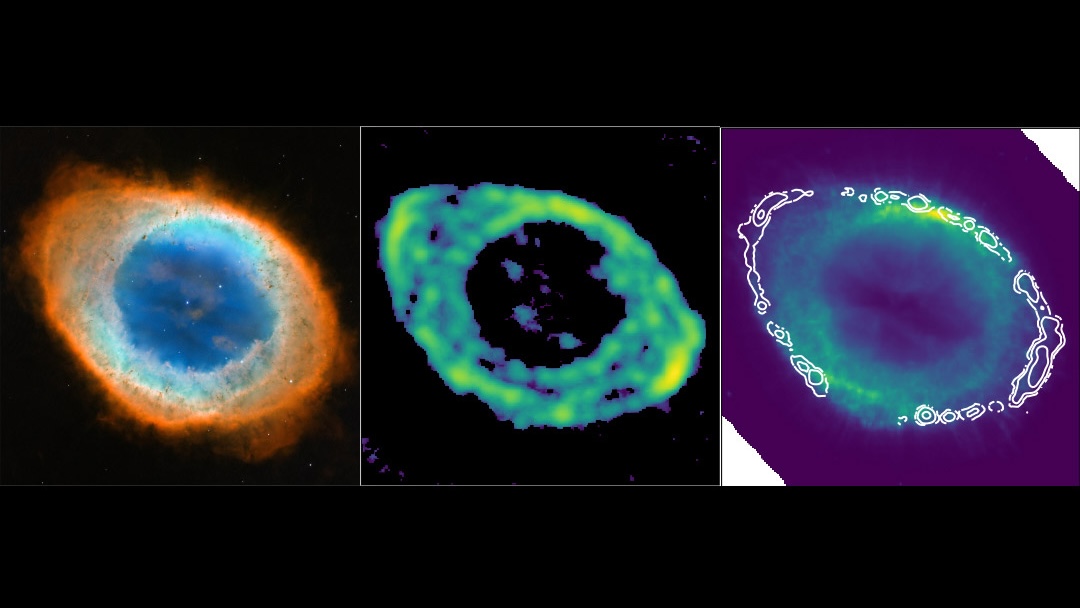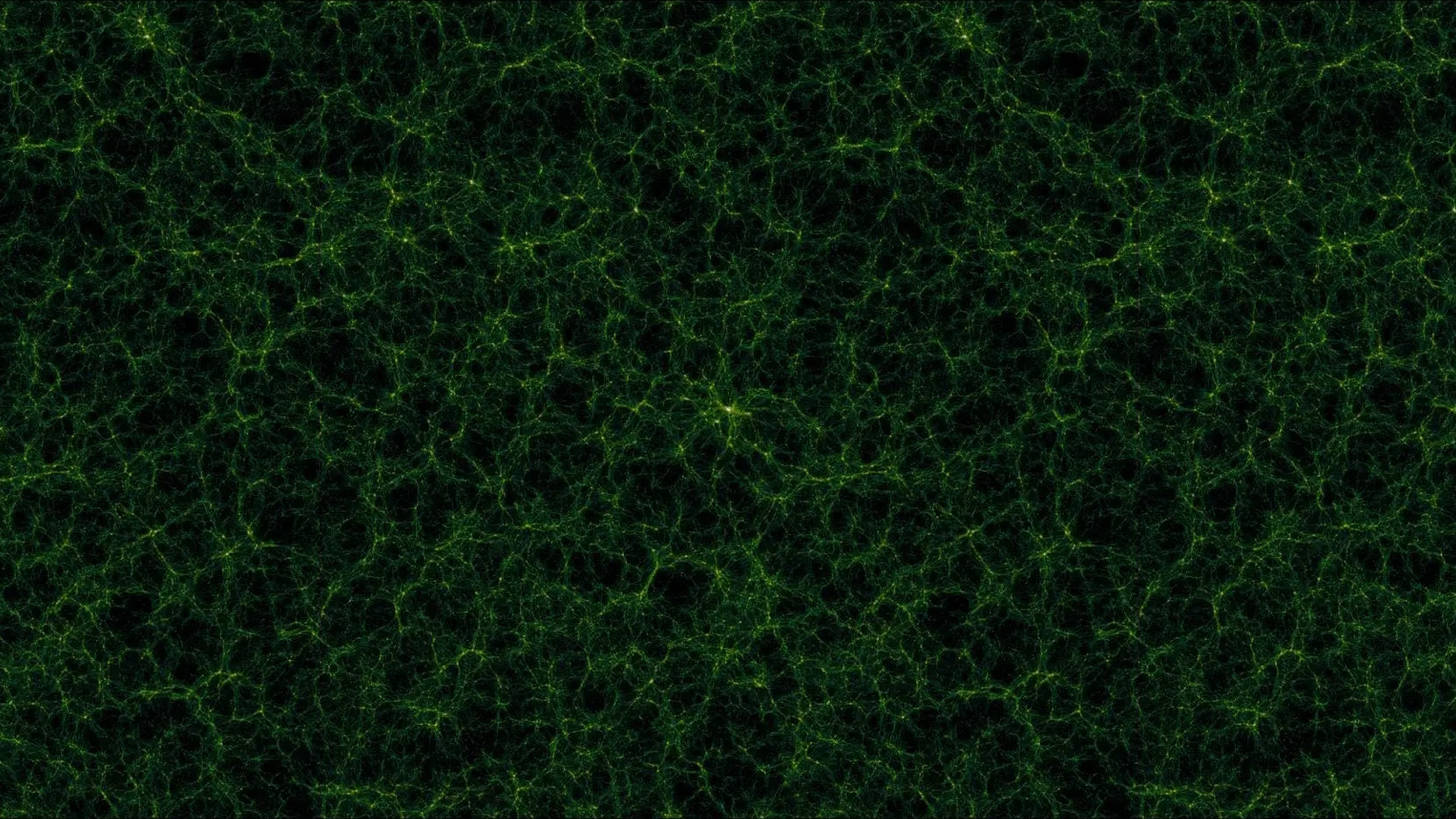Messier Monday: The Omega Nebula, M17
Perhaps the most spectacular example of rebirth in our galaxy, this cavernous nebula is giving rise to the next generation of stars!
Image credit: ESO, via http://www.eso.org/public/images/eso0925a/.
“For in the final analysis, our most basic common link is that we all inhabit this small planet. We all breathe the same air. We all cherish our children’s futures. And we are all mortal.” –John F. Kennedy
Imagine you could go back in time, 4.6 billion years ago, to when the giant molecular gas cloud that would give rise to the Sun, Earth, and around a thousand other stars first began to collapse. Initially overdense regions attracted more and more matter, accruing larger amounts of mass in a runaway gravitational process, until finally the temperatures and densities at the center were enough to ignite nuclear fusion. After that, a race begins: between the newly formed star(s) emitting radiation energetic enough to destroy the young nebula, and gravitational attraction in other overdense regions to form new stars.
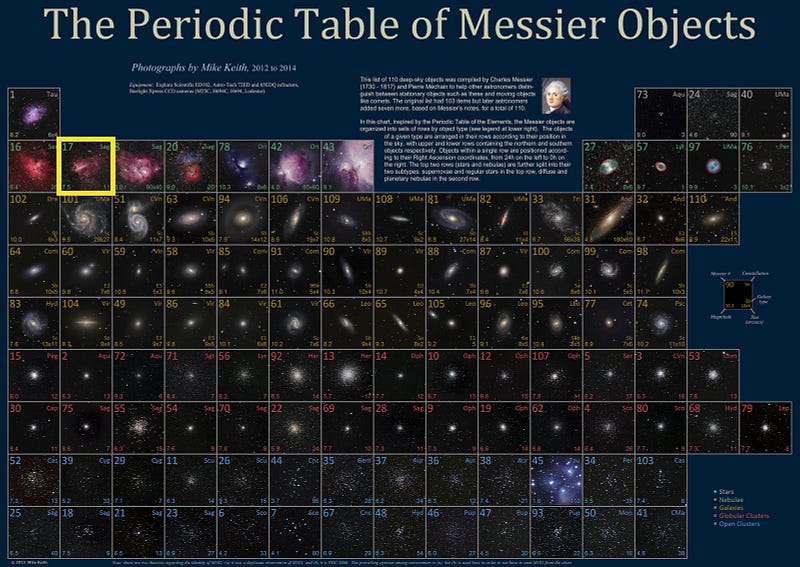
Although this story only represents 7 of the 110 objects in the Messier catalogue, these seven objects are all contained within our galaxy and are not only home to some of the youngest stars we know of, but home to some of the most likely candidates to be the very next supernova in the Milky Way, and visible to the naked eye!
Today’s object — Messier 17, the Omega Nebula — is not only one of the most spectacular examples of this, it’s also one of the most accessible to amateur and professional skywatchers. Here’s how to find it.
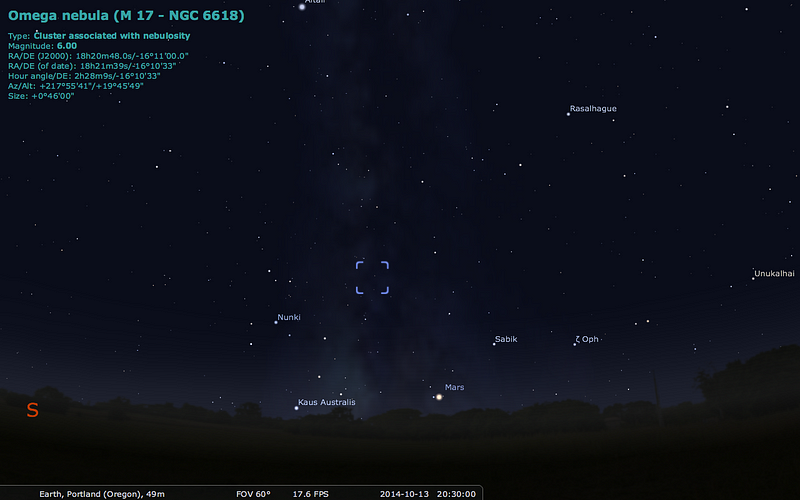
The constellation of Sagittarius is incredibly rich in terms of stars, star clusters and new, star-forming nebulae. This shouldn’t come as a surprise: that’s the direction that the center of our galaxy is located! There’s simply more opportunity here for such objects to be found, and the Universe rewards those who look in likely places.
Sagittarius is well-known for its collection of stars that look like a teapot, most clearly visible above the southern horizon in summer but still visible in the southwest in the early part of the night here in October. The “top” of the teapot’s dome is marked by the star Kaus Borealis, which will make an easy-to-find guide towards Messier 17.
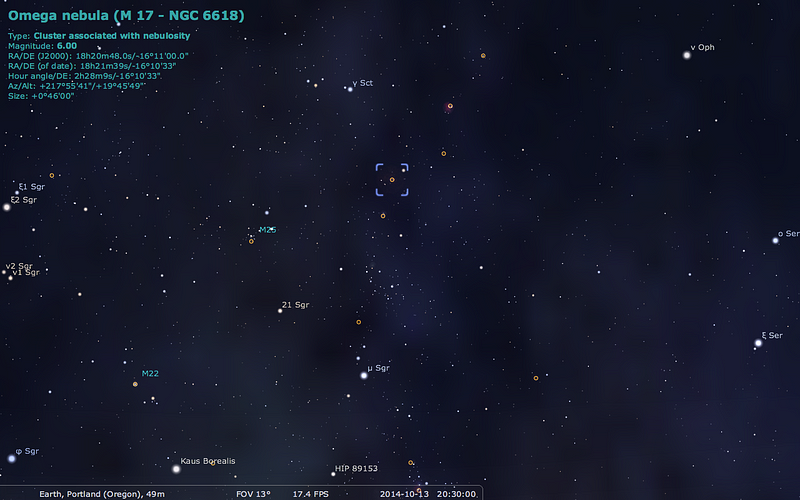
If you rise “up” from the top of the teapot’s dome, you’ll run into the prominent star μ Sagittarii, and then if you continue upwards and curve to the left you’ll run into the dimmer γ Scuti, which is still prominent due to the fact that it’s significantly brighter than all the other stars in its vicinity. If you follow that curve from μ Sagittarii to γ Scuti, you’ll find a number of faint (but still naked-eye) stars between them, with the one closest to γ Scuti — HIP 89851, about 2.5° west/southwest of this latter star — the one you’ll want to focus in on.
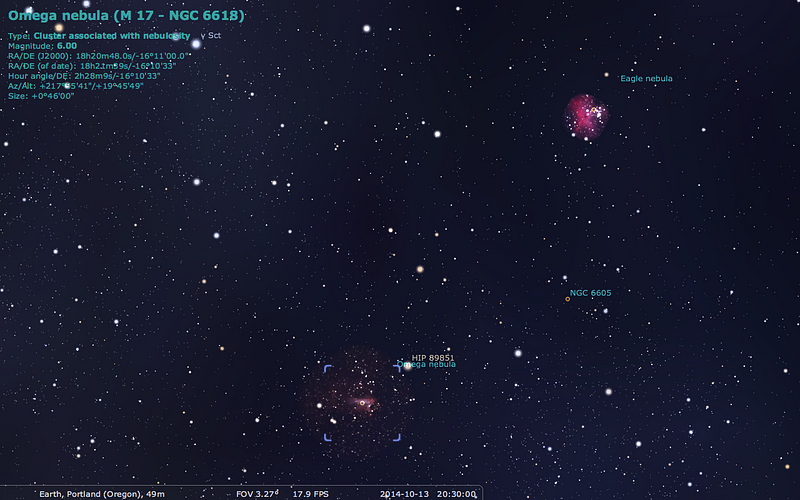
Because adjacent to this star lies exactly the faint, fuzzy, nebular object we’re setting our sights on: Messier 17, the Omega Nebula. It was catalogued by Messier back in 1764, where he described it as:
A train of light without stars, of 5 or 6 minutes in extent, in the shape of a spindle, & a little like that in Andromeda’s belt but of a very faint light…
It’s hard to blame him for such a description; through a modern small telescope (with a good camera), it looks something like this.
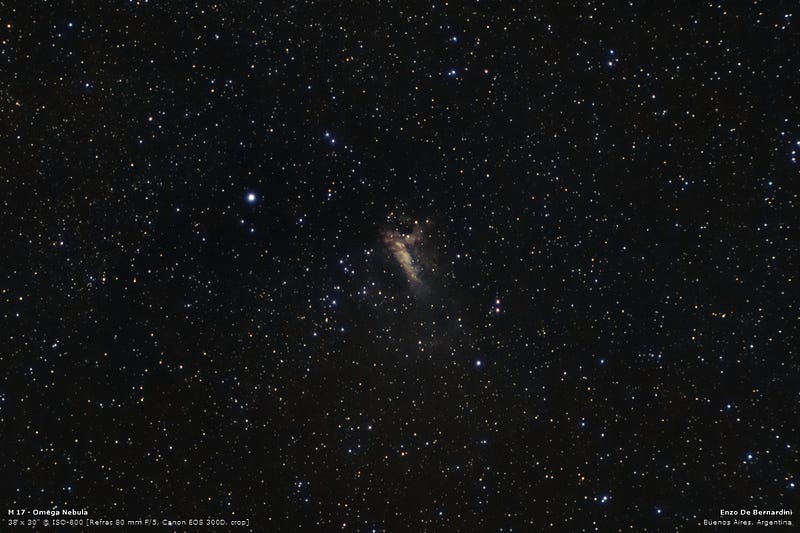
But this “smudge” on the sky is much, much more than what it appears to be to the naked eye. What appears to be a small, irregular cloud emitting light and darkened by a few light-absorbing dust lanes is instead a giant cosmic star factory viewed from a great distance: some 5,500 light years away!
If we’re willing to look in a variety of different wavelengths of light and expose some essential elements, we can literally open up and peer into an entire new Universe.
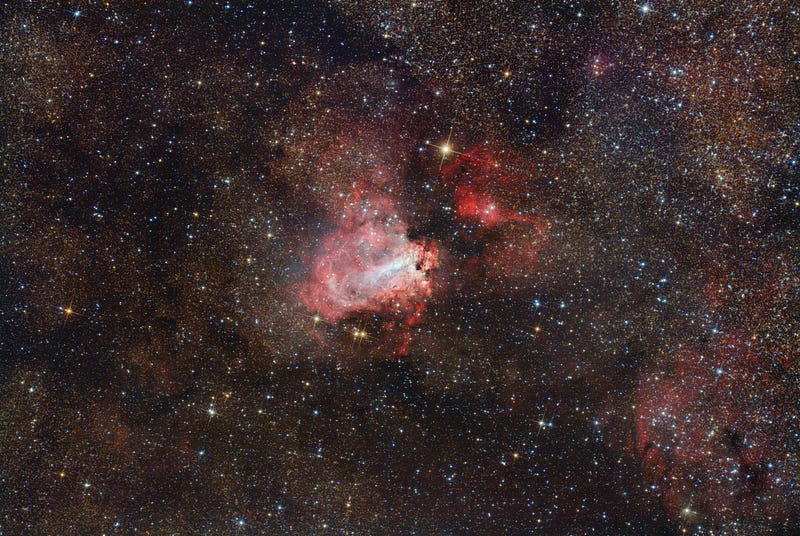
Even with the breathtaking backdrop of the galactic plane behind it, and the thousands of stars visible to a quality telescope, it’s impossible to overlook this wonderland of new star birth. Just 15 light-years in diameter, the nebula proper (the bright part) contains anywhere from a few hundred stars all the way up into possibly the low thousands, at the center of a diffuse molecular cloud extending for at least an additional 25 light-years across and containing an estimated 30,000 solar masses worth of matter.
The bright red glow you see is indicative of ionized hydrogen, recombining to emit a characteristic spectrum of light, the brightest visible component of which is at 656.3 nanometers: the red you see above.
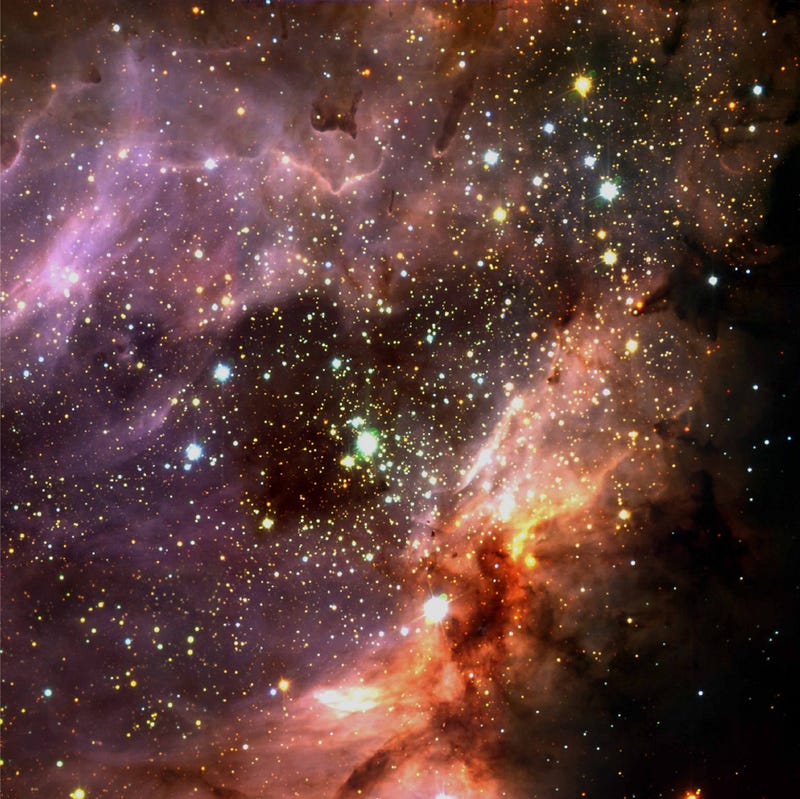
If we look at the right combinations of wavelengths, we can take a peek at the stars inside the nebula, finding around 100 bright, blue, young stars, with a number of evolved blue hypergiants and a total of nine O-class stars, all candidates for becoming Type II supernovae in the not-too-distant future! That could be tomorrow or in a few hundred-thousand years, but on astronomical timescales, these stars are destined for a spectacular funeral visible across the galaxy.
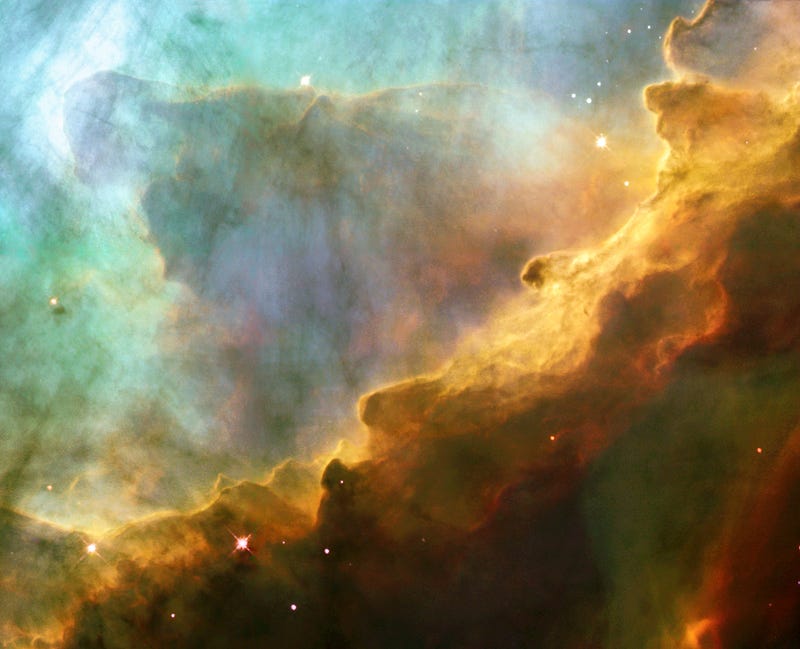
The brightest, hottest stars (like the one at the top left, above) are the ones that emit the most intense ionizing radiation, burning off the gas that’s working to collapse, form new stars and grow already existing stars, some of which are beginning to peek through the “evaporating gaseous globules” in the ribbon running from the bottom left to the top right of the image above. Although estimating the total number of stars is very difficult, based on the size, frequency and brightness of the whole nebula and the brightest stars within it, it probably has significantly more stars within it than the entire Orion Nebula, which would place the total number somewhere between 3,000 and 5,000, although it’s difficult to know for certain, as the lowest-mass stars are obscured beyond observation with current technology.
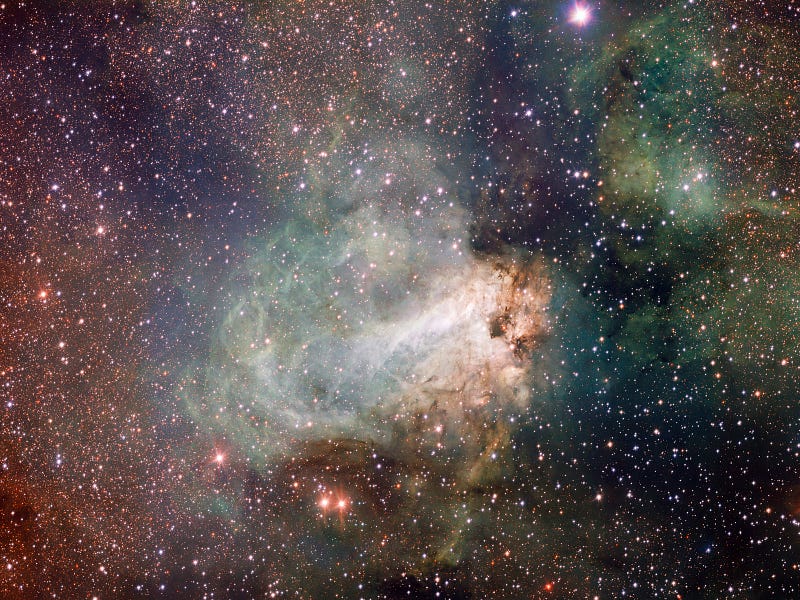
There’s a slew of interesting phenomena going on in here, including:
- the ionized hydrogen plasma emitting red light due to electrons recombining with the ionized hydrogen nuclei,
- a large amount of blue light coming from various parts of the nebula, as the blue light from the brightest stars reflects off of the neutral gas,
- newborn stars — most of which are under 1,000,000 years old — mostly obscured by the neutral gas of the nebula,
- ionizing radiation working to burn off the gas and put a stop to the new star formation,
- gravitation working like mad to attract as much of the gas as possible and bind it up in new stars, and
- multiwavelength spectra revealing the ubiquitous presence of heavy elements beyond hydrogen, including carbon, oxygen, sulphur, silicon and more!
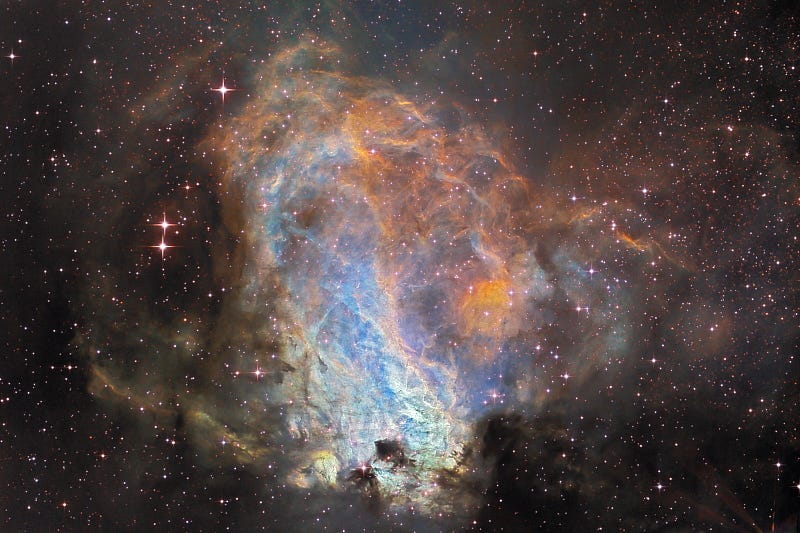
The image above highlights a few of these — oxygen in blue, sulphur in red, and hydrogen in green — but that’s something that we don’t even need to look beyond the visible to discover. It’s long-exposure images like this that can bring out the faint details at the outskirts, teaching us that the total extent of the nebula ranges from 40-to-50 light years in diameter, or three times the size of the bright core.
But we’re not restricted to the visible; we can look in hugely different wavelengths all over the electromagnetic spectrum. And when we do, we can learn even more.
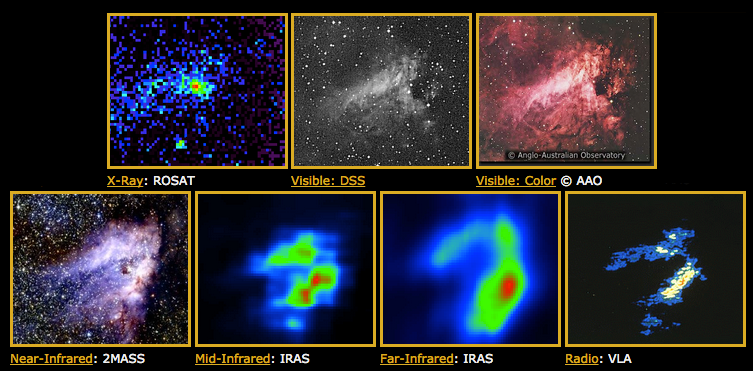
The longest wavelength IRAS image (in the far-IR) reveals interstellar dust, which accounts for the dark dust lanes obscuring our view of portions of this nebula. That dust is invisible in the near-IR (the 2MASS image), and hence is lit up brightly. The X-ray shows either a faint source at the center (possible a black hole already!) or perhaps a background, coincidental quasar. The gas revealed in the mid-IR is the right temperature to form new stars, and likely represents the most active regions of star formation, while the radio wavelengths showcase the most heavily ionized regions.
This is as much a glimpse into the formation of new stars today as it is a window into the conditions under which our Solar System first formed a third of the age of the Universe ago! Have a look at the most spectacular view of this nebula I’ve ever seen, which showcases just how powerful the stellar winds from the most massive stars are, and the cavernous structures created in the nebula’s gas as a result!
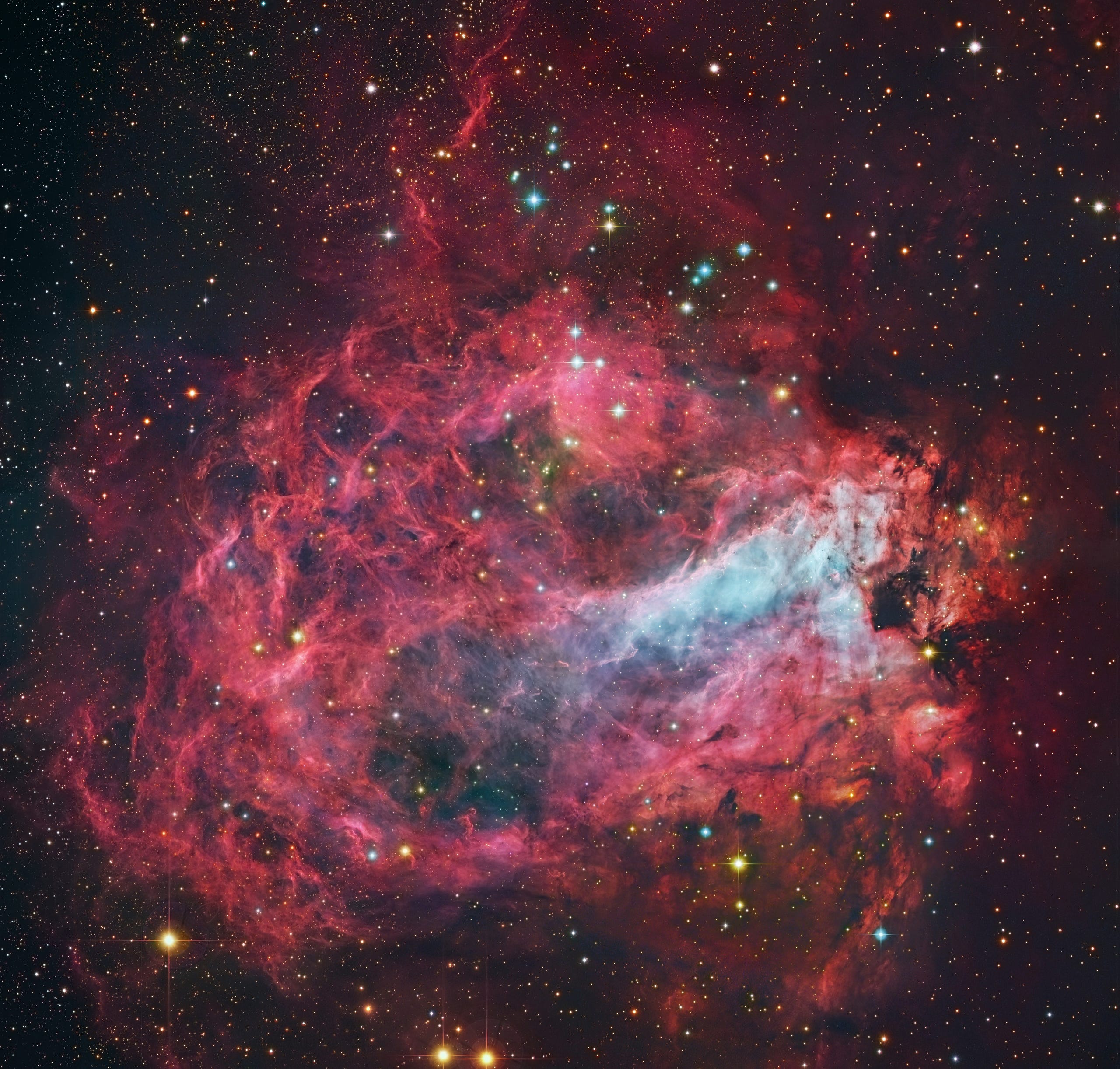
Processing: Robert Gendler & Roberto Colombari, via http://apod.nasa.gov/apod/ap140527.html.
The brightest stars here — the blue and red giants — will all be gone in just a few million years, resulting in between one-and-three dozen supernovae that will illuminate not only our skies, but the skies of watchers across our galaxy. In a few tens of millions years more, the entire nebula will be gone as well, having evaporated away completely. At that time, all that will be left is a bright open cluster of thousands of stars, which will slowly dissociate due to gravitational interactions, eventually leading to thousands of isolated star systems not so different from our own: with planets, asteroids, comets, heavy elements, organic molecules, and chances for life.
And with that final glimpse into not only our cosmic past but the future of our local Universe, we come to the end of one of the most spectacular Messier Mondays in recent memory. With the Omega Nebula complete, we have only six Messier Mondays left before our series is done! Take a look back at all our previous entries here:
- M1, The Crab Nebula: October 22, 2012
- M2, Messier’s First Globular Cluster: June 17, 2013
- M3, Messier’s First Original Discovery: February 17, 2014
- M4, A Cinco de Mayo Special: May 5, 2014
- M5, A Hyper-Smooth Globular Cluster: May 20, 2013
- M6, The Butterfly Cluster: August 18, 2014
- M7, The Most Southerly Messier Object: July 8, 2013
- M8, The Lagoon Nebula: November 5, 2012
- M9, A Globular from the Galactic Center: July 7, 2014
- M10, A Perfect Ten on the Celestial Equator: May 12, 2014
- M11, The Wild Duck Cluster: September 9, 2013
- M12, The Top-Heavy Gumball Globular: August 26, 2013
- M13, The Great Globular Cluster in Hercules: December 31, 2012
- M14, The Overlooked Globular: June 9, 2014
- M15, An Ancient Globular Cluster: November 12, 2012
- M17, The Omega Nebula: October 13, 2014
- M18, A Well-Hidden, Young Star Cluster: August 5, 2013
- M19, The Flattened Fake-out Globular: August 25, 2014
- M20, The Youngest Star-Forming Region, The Trifid Nebula: May 6, 2013
- M21, A Baby Open Cluster in the Galactic Plane: June 24, 2013
- M22, The Brightest Messier Globular: October 6, 2014
- M23, A Cluster That Stands Out From The Galaxy: July 14, 2014
- M24, The Most Curious Object of All: August 4, 2014
- M25, A Dusty Open Cluster for Everyone: April 8, 2013
- M27, The Dumbbell Nebula: June 23, 2014
- M28, The Teapot-Dome Cluster: September 8, 2014
- M29, A Young Open Cluster in the Summer Triangle: June 3, 2013
- M30, A Straggling Globular Cluster: November 26, 2012
- M31, Andromeda, the Object that Opened Up the Universe: September 2, 2013
- M32, The Smallest Messier Galaxy: November 4, 2013
- M33, The Triangulum Galaxy: February 25, 2013
- M34, A Bright, Close Delight of the Winter Skies: October 14, 2013
- M36, A High-Flying Cluster in the Winter Skies: November 18, 2013
- M37, A Rich Open Star Cluster: December 3, 2012
- M38, A Real-Life Pi-in-the-Sky Cluster: April 29, 2013
- M39, The Closest Messier Original: November 11, 2013
- M40, Messier’s Greatest Mistake: April 1, 2013
- M41, The Dog Star’s Secret Neighbor: January 7, 2013
- M42, The Great Orion Nebula: February 3, 2014
- M44, The Beehive Cluster / Praesepe: December 24, 2012
- M45, The Pleiades: October 29, 2012
- M46, The ‘Little Sister’ Cluster: December 23, 2013
- M47, A Big, Blue, Bright Baby Cluster: December 16, 2013
- M48, A Lost-and-Found Star Cluster: February 11, 2013
- M49, Virgo’s Brightest Galaxy: March 3, 2014
- M50, Brilliant Stars for a Winter’s Night: December 2, 2013
- M51, The Whirlpool Galaxy: April 15th, 2013
- M52, A Star Cluster on the Bubble: March 4, 2013
- M53, The Most Northern Galactic Globular: February 18, 2013
- M54, The First Extragalactic Globular: September 22, 2014
- M55, The Most Elusive Globular Cluster: September 29, 2014
- M56, The Methuselah of Messier Objects: August 12, 2013
- M57, The Ring Nebula: July 1, 2013
- M58, The Farthest Messier Object (for now): April 7, 2014
- M59, An Elliptical Rotating Wrongly: April 28, 2014
- M60, The Gateway Galaxy to Virgo: February 4, 2013
- M61, A Star-Forming Spiral: April 14, 2014
- M62, The Galaxy’s First Globular With A Black Hole: August 11, 2014
- M63, The Sunflower Galaxy: January 6, 2014
- M64, The Black Eye Galaxy: February 24, 2014
- M65, The First Messier Supernova of 2013: March 25, 2013
- M66, The King of the Leo Triplet: January 27, 2014
- M67, Messier’s Oldest Open Cluster: January 14, 2013
- M68, The Wrong-Way Globular Cluster: March 17, 2014
- M69, A Titan in a Teapot: September 1, 2014
- M70, A Miniature Marvel: September 15, 2014
- M71, A Very Unusual Globular Cluster: July 15, 2013
- M72, A Diffuse, Distant Globular at the End-of-the-Marathon: March 18, 2013
- M73, A Four-Star Controversy Resolved: October 21, 2013
- M74, The Phantom Galaxy at the Beginning-of-the-Marathon: March 11, 2013
- M75, The Most Concentrated Messier Globular: September 23, 2013
- M77, A Secretly Active Spiral Galaxy: October 7, 2013
- M78, A Reflection Nebula: December 10, 2012
- M79, A Cluster Beyond Our Galaxy: November 25, 2013
- M80, A Southern Sky Surprise: June 30, 2014
- M81, Bode’s Galaxy: November 19, 2012
- M82, The Cigar Galaxy: May 13, 2013
- M83, The Southern Pinwheel Galaxy, January 21, 2013
- M84, The Galaxy at the Head-of-the-Chain, May 26, 2014
- M85, The Most Northern Member of the Virgo Cluster, February 10, 2014
- M86, The Most Blueshifted Messier Object, June 10, 2013
- M87, The Biggest One of them All, March 31, 2014
- M88, A Perfectly Calm Spiral in a Gravitational Storm, March 24, 2014
- M89, The Most Perfect Elliptical, July 21, 2014
- M90, The Better-You-Look, The Better-It-Gets Galaxy, May 19, 2014
- M91, A Spectacular Solstice Spiral, June 16, 2014
- M92, The Second Greatest Globular in Hercules, April 22, 2013
- M93, Messier’s Last Original Open Cluster, January 13, 2014
- M94, A double-ringed mystery galaxy, August 19, 2013
- M95, A Barred Spiral Eye Gazing At Us, January 20, 2014
- M96, A Galactic Highlight to Ring in the New Year, December 30, 2013
- M97, The Owl Nebula, January 28, 2013
- M98, A Spiral Sliver Headed Our Way, March 10, 2014
- M99, The Great Pinwheel of Virgo, July 29, 2013
- M100, Virgo’s Final Galaxy, July 28, 2014
- M101, The Pinwheel Galaxy, October 28, 2013
- M102, A Great Galactic Controversy: December 17, 2012
- M103, The Last ‘Original’ Object: September 16, 2013
- M104, The Sombrero Galaxy: May 27, 2013
- M105, A Most Unusual Elliptical: April 21, 2014
- M106, A Spiral with an Active Black Hole: December 9, 2013
- M107, The Globular that Almost Didn’t Make it: June 2, 2014
- M108, A Galactic Sliver in the Big Dipper: July 22, 2013
- M109, The Farthest Messier Spiral: September 30, 2013
And join us next week for one of the last remaining wonders in this catalogue!
Leave your comments at the Starts With A Bang forum on Scienceblogs!

